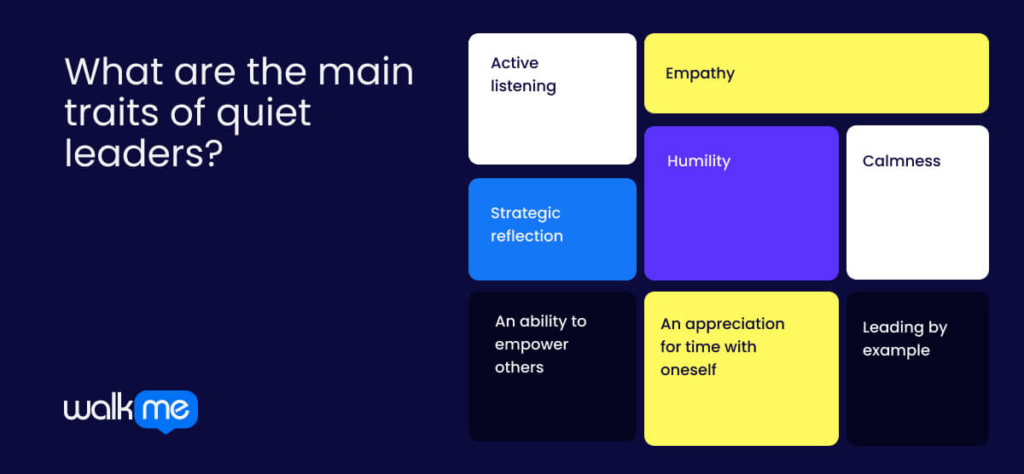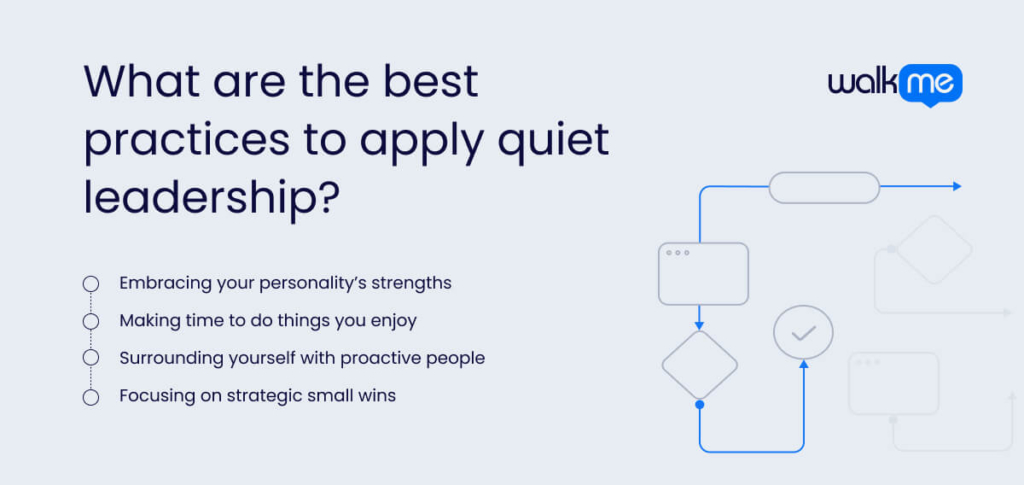Many believe effective leadership should be loud, engaging, and charismatic. But this is not always true. Quiet leaders are often overlooked, yet they bring unique qualities that make them highly effective.
Quiet leadership is not about being shy or timid—it’s about leading calmly and thoughtfully, creating stability that improves the employee experience. This steady approach can be especially valuable in times of change management, where clear guidance and consistency help teams adapt with confidence.
In this article, we will define quiet leadership and its main traits. We will also look at examples of quiet leaders and best practices for using this style in the workplace. Finally, we will discuss the pros and cons of quiet leadership.
What is quiet leadership?
Quiet leadership is a leadership style defined by empathy, creativity, active listening, and attention to detail. It focuses on collaboration and communication instead of control. At its core is quiet confidence, not arrogance.
Quiet leaders prefer to solve problems through teamwork and encouragement, not aggression. They are compassionate, understanding, open, and approachable. Most importantly, they earn their team’s respect instead of demanding it.
What are the main traits of quiet leaders?

The main traits of quiet leaders are distinctive qualities that enable them to lead effectively without the need for loudness or overt authority.
These leaders rely on subtle strengths, such as active listening, empathy, and humility, to create a supportive and empowering environment. They often lead through thoughtful reflection, calm composure, and by setting an example for others to follow.
Active listening
Quiet leaders are great listeners and skilled observers. They don’t just hear what people say; they notice what isn’t said. They pay attention to body language, energy, and emotional cues. The quiet leadership approach gives team members time and space to share their thoughts.
Empathy
One of the main characteristics of a quiet leader is being able to understand or empathize with the needs, motivations, and concerns of all. This begins from top executives to front-line workers.
This ability helps them build strong relationships with all team members. It allows them to connect with people deeper, fostering trust and encouraging collaboration.
Strategic reflection
Quiet leaders know that taking time to make decisions allows for strategic reflection.
Quiet leadership allows you to explore the problem’s complexities. They seek advice from others who have faced similar challenges and examine the issue from different angles. Instead of rushing ahead, they nudge, test, and gradually increase their efforts in a data-driven direction.
Humility
A quiet leader shows humility in both success and failure. They recognize that great achievements come from teamwork. In success, they credit their team. In failure, they accept constructive criticism. They view setbacks as opportunities to learn. This mindset fosters a culture of resilience and growth within the team.
Calmness
This type of leader excels at staying calm in stressful situations. Whether they’re making a major decision or presenting to a key investor, they manage to remain composed. This ability to stay level-headed during crises can positively impact the overall company culture.
An appreciation for time with oneself
Quiet leaders value solitude. They often process their thoughts internally, so they work best when they have personal space. This could be in an office with a closed door or headphones in a busy workspace. With this alone time, quiet leaders can tackle tough tasks like strategic planning and product innovation.
An ability to empower others
Quiet leaders prefer to stay in the background rather than be the center of attention. They allow others to shine and grow into future leaders. They are kind and understanding, providing support and guidance while setting high standards.
These leaders often make great coaches and mentors. They can express what others find hard to say or see.
Leading by example
This type of leadership rarely involves asking team members to do anything they wouldn’t do themselves. Quiet leaders also don’t cut corners by ignoring processes or taking extra perks.
Instead, they follow the same company policies and guidelines as everyone else. This way, they lead by example.
What are some examples of quiet leaders?
Here are some common examples of quiet leaders for you to emulate:
Marissa Meyer
Marissa Mayer couldn’t avoid the spotlight as Yahoo’s CEO. But, she preferred working behind the scenes.
Instead, Mayer had to train herself to step out of her comfort zone.
Her ability to recognize her limits and push through challenges helped her succeed as CEO. This self-awareness and resilience make her an excellent example of quiet leadership.
Steve Wozniak
Apple co-founder Steve Wozniak, a quiet leader, valued working alone. He believed inventors do their best when they control their designs without outside input.
But Apple wouldn’t exist if he had truly worked alone. While he invented in private, he co-founded Apple with Steve Jobs, an extrovert.
Wozniak’s self-awareness, a common introvert strength, helped him see the value in partnering with Jobs.
What are the best practices to apply quiet leadership?

The main best practices you need to apply quiet leadership involve:
Embracing your personality’s strengths
Instead of criticizing yourself for not being an extroverted leader, embrace who you are. Don’t try to be someone you’re not.
You might wonder if a quiet style can work because of leadership stereotypes. But in reality, it can be comforting to others. Build self-awareness and notice how you positively impact people.
By accepting your unique leadership style, you’ll find what works best for you and your team. If you use your strengths, being a quiet leader can be a superpower. For example, quiet leaders are great listeners. Active listening is rare, so be proud if you have that skill.
Making time to do things you enjoy
As a quiet leader, you’ll need to step outside your comfort zone at times. This can be exhausting, so make time to recharge and regain energy. Plan your schedule carefully. After a day of meetings, follow up with some quiet, focused work.
Find activities that help you recharge and reconnect with yourself. These could be gym sessions, meditation, or a day at the beach.
Make sure you do things you truly enjoy. Burnout often comes from doing too little of what makes us happy. Quiet leaders need energizing projects and activities to stay balanced.
Surrounding yourself with proactive people
Quiet leaders focus on helping others grow and possess unique skills. To build a strong team, hire proactive employees who collaborate, share ideas, and view conflicts as growth opportunities.
This approach fosters faster innovation and problem-solving. Ask candidates about their past contributions to ensure a good fit.
Regularly check in with your staff for feedback and maintain an open-door policy for easy communication. One-on-one meetings help strengthen relationships and encourage honest conversations.
Discuss successes, failures, and obstacles together. Act on their feedback to show you value their input. Create a safe space for employees to share ideas and innovate.
Focusing on strategic small wins
Building your quiet leadership style takes time and consistency. Don’t expect to change overnight; it’s a learning process.
Start with a simple goal, like asking two questions in your next meeting. You could also focus on connecting with one new person at your company weekly. Regular practice will improve your skills.
Be yourself. Authenticity is key.
You can gradually step outside your comfort zone. Don’t try to fit into an ideal that isn’t you. Embrace your strengths and unique viewpoint. Over time, small interactions will help you build strong relationships across the organization.
What are the benefits of quiet leadership?

The most important benefits of quiet leadership are:
Encourages deep reflection
Quiet leaders are skilled at handling complex challenges. They think deeply and analyze problems carefully. By considering many options, they find innovative solutions.
This approach helps them solve problems creatively. They focus on the task and take their time to form their opinions. It’s important not to jump to conclusions.
Empowers team members
The quiet leadership style builds trust through open communication. Quiet leaders listen to their staff and stakeholders before making decisions.
They gather different perspectives, making people feel valued. This type of leader focuses on their employees and celebrates their contributions. As a result, team members become more engaged and productive.
Compels long-term thinking
Quiet leaders are objective in their views and choices. They rely on data and analysis rather than emotions.
They take time to process information. It’s important to respond thoughtfully instead of reacting impulsively.
By doing this, they encourage long-term thinking that helps the organization. They avoid rushing into decisions.
What are the challenges of implementing quiet leadership?
The vital challenges of implementing quiet leadership are:
Can be seen as too silent
Silence is comfortable for a quiet leader. They often prefer listening instead of talking. Because of this, some may see their silence as a lack of confidence or leadership skills.
To address this, practice sharing your thoughts. Speak with confidence. Ensure others see that your decisions come from deep understanding, not uncertainty.
Being too focused on harmony
As a quiet leader, you may feel proud of being a peacemaker and value building good relationships. But sometimes, moving forward means challenging the usual approach and having tough conversations.
You must know when to prioritize progress over peace. This could mean disagreeing with a plan or giving honest feedback to a coworker.
Does not fit with all types of organizational cultures
The quiet leadership style doesn’t work for every leader or organization. It suits leaders who are naturally introverted and have good emotional intelligence and communication skills.
Extroverted leaders might find a quiet approach difficult and prefer a more vocal style. Also, organizations that value speaking up may not welcome a quiet leader.
Use a quiet leadership approach to thoroughly analyze decisions before making them
Quiet leadership emphasizes listening, empathy, and humility. Though less flashy than other styles, it helps build teamwork, boost morale, and increase employee productivity.
This leadership isn’t about being silent but using thoughtful communication and creating space for others to contribute. It works best when the organization’s culture supports it. Leaders need emotional intelligence and strong communication skills to implement it effectively.
However, it requires a careful examination of team dynamics and organizational fit. When done well, it can unlock potential, fostering ownership, autonomy, and motivation in employees.
FAQs
You can develop a quiet leadership style by improving your active listening skills, reflecting on tasks, and creating an environment where others feel encouraged to speak up and contribute.
Quiet leadership can inspire trust and motivate others through actions. Authoritarian leadership can create discipline and efficiency. However, the best leaders often find a balance between these styles. They adapt to the needs of their team and the situation at hand.
Quiet leadership is most effective when you want to create an inclusive and collaborative environment. In this space, colleagues feel empowered to share their ideas and suggestions, knowing they will be heard.

